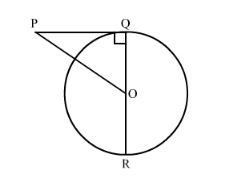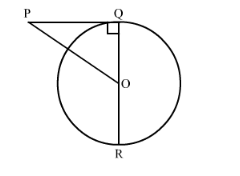In the given figure, OQ : PQ = 3.4 and perimeter of Δ POQ = 60 cm. Determine PQ, QR and OP.

In the figure,

$\angle P Q O=90^{\circ}$. Therefore we can use Pythagoras theorem to find the side $P O$.
$P O^{2}=P Q^{2}+O Q^{2} \ldots \ldots(1)$
In the problem it is given that,
$\frac{O Q}{P Q}=\frac{3}{4}$
$O Q=\frac{3}{4} P Q$......(2)
Substituting this in equation (1), we have,
$P O^{2}=\frac{9 P Q^{2}}{16}+P Q^{2}$
$P O^{2}=\frac{25 P Q^{2}}{16}$
$P O=\sqrt{\frac{25 P Q^{2}}{16}}$
$P O=\frac{5}{4} P Q$ ........(3)
It is given that the perimeter of ![]() is 60 cm. Therefore,
is 60 cm. Therefore,
PQ + OQ + PO = 60
Substituting (2) and (3) in the above equation, we have,
$P Q+\frac{3}{4} P Q+\frac{5}{4} P Q=60$
$\frac{12}{4} P Q=60$
$3 P Q=60$
$P Q=20$
Substituting for PQ in equation (2), we have,
$P O=\frac{5}{4} \times 15$
$O Q=\frac{3}{4} \times 20$
$O Q=15$
OQ is the radius of the circle and QR is the diameter. Therefore,
QR = 2OQ
QR = 30
Substituting for PQ in equation (3), we have,
$P O=\frac{5}{4} \times 20$
$P O=25$
Thus we have found that PQ = 20 cm, QR = 30 cm and PO = 25 cm.
